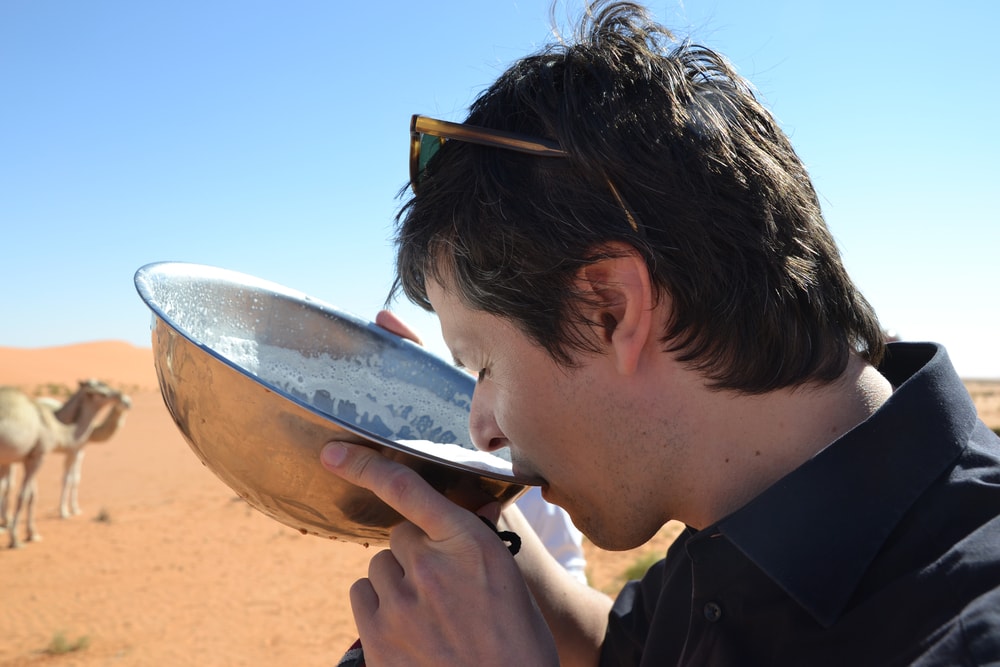The Australian Camel Milk Industry To Meet Global Demand?

Cultural Authenticity, Beechworth Post Office, Disabled Access…
June 19, 2018Berry Punnets From Timber Offcuts. Waste Free ‘Circularity’
July 30, 2018Back in June 2006, given the large numbers of wild camels in Australia and the purported health benefits of camel milk, PWF asked: “Any Entrepreneurs Interested In Camel Milk?” The idea of rounding up and milking camels was daunting, but today there are camel dairies in WA, Victoria, Queensland, SA and NSW.
Production Increasing To Meet Local & Global Demand
The GoodFood online newsletter recently reported on two Australian camel milk producers increasing production to meet overseas demand.
“WA’s Good Earth Dairy CEO, Marcel Steingiesser, gave up a 14-year career as a chemical engineer with BHP-Billiton, to stake his future on Australian camel milk.
Although demand is growing globally there are not enough camels available globally to supply that quantity of milk…retailing for up to $25 AUD a litre in parts of Asia.
Australia can fill that gap because it’s home to the biggest herd of wild camels in the world…The mob is growing at about 8 per cent a year and the population could double in the decade to 2020. Wild camels can be caught and domesticated.
Scale is key to getting production costs lower, says Marcel. He aims to push costs down to $1 AUD a litre. He didn’t say what they were currently.
Victoria-based The Camel Milk Co. of Australia has doubled output in the past year and now makes 250 litres a day from a herd of 250 animals.
Founder Megan Williams has moved to a farm four times the size. The dairy can hold up to 1,000 camels and Megan says supply will increase as demand grows. Camels are milked alongside their suckling young.”
Development Of The Australian Camel Milk Industry
Twelve months ago, representatives of the sector met in Adelaide for the Australian Camel Milk Industry Forum, aimed at devising a pathway forward.
“WA representative and Calamunnda Camel Farm director Chris O’Hora, has watched the industry grow in the past seven years from his vantage point as operator of Australia’s first commercial camel dairy.
He says as a new industry, there are a few hurdles to negotiate.
“We proved the concept that camel milk could be brought to the marketplace…
What’s missing from the industry, in its burgeoning stages, is research in the Australian environment to prove the benefits of camel milk…Camel milk has been touted as having health benefits…
We need a good set of data derived from well-designed set of experiments that are reliable…
Vet knowledge, transport – all the things that support an industry all need to be developed on multiple levels.”
Camel Milk: Its Qualities & Its Health Benefits
Below is a summary of the information and various claims made about camel milk by the ever-increasing number of Australian camel dairies. A list of producers’ websites – containing their stories – can be found at the end of this article.
Camel milk is nutritious. It is closest to human milk and unlike cows’ and goats’ milk it has no side effects or health issue. Dromedary milk is tasty – makes wonderful chocolate apparently – and has been part of a healthy Bedouin diet for millennia!
Camel milk is 50 times costlier than cows’ milk to ‘harvest’. Online prices seem to vary from $14 – $21/litre. It has a 2.5 week shelf life once bottled and can be frozen for up to 6 weeks from the use-by date. In the UK, mainstream supermarket Asda, an arm of Walmart, is now selling camel milk.
Camel milk does NOT contain ‘two nasty whey proteins’ that cause intolerances. It is naturally packed with Lactoferrin for fighting bacteria and healing the gut
Promotes Gut Health?
For those with gut and bowel problems, camel milk is soothing on the gut. Unlike cow’s or goat’s milk, it doesn’t coagulate in the stomach, making it far more digestible. People often report that drinking a glass of camel milk for breakfast fill them up and kills their appetite.Helps With Inflammatory Bowel Disease? The mechanisms of Inflammatory Bowel Disease are correlated to oxidative stress caused by an over-amplified immune response. Camel milk inhibits an enzyme related to the immune response.
A Safe Substitute for Milk Allergies?
Camel milk does not contain beta-lactoglobulin or A1 casein, the two proteins found in cow’s milk that are responsible for allergic reactions. It has antibiotic properties that help fight bacteria and infections from food allergies, especially in children.Lowers Blood Sugar Levels?
Dromedary milk contains an insulin-like protein. For diabetes sufferers, drinking camel milk may offer a natural way to improve blood sugar levels while significantly reducing the need for daily doses of insulin.A Help With Autism?
Often challenged is the claim that camel milk ‘treats’ autism, yet there is much published research and anecdotal evidence of camel milk helping autism sufferers. Autism spectrum disorders are may be caused by a number of factors, such as ‘oxidative stress’, which, according to Lori Chong at The Ohio State University Wexner Medical Centre, has been shown to be lowered by camel milk consumption causing the body to increase production of antioxidant enzymes.Crohn’s Disease/Autoimmunity
Research suggests the anti-inflammatory immunity-strengthening qualities found in camel milk can help with Crohn’s and Autoimmunity diseases. Ongoing research will continue to examine potential relief for sufferers.
Australian Camel Milk Dairies
The Good Earth Dairy – Dandaragan, 180 km north of Perth, Western Australia.
The Camel Milk Co. Australia – based in Kyabram, Victoria.
Australian Camel Milk Dairy Chris O’Hora’s Calamunnda Camel Farm was Australia’s first camel dairy, in Paulls Valley on the outskirts of Perth, WA…a significant tourism attraction. https://www.facebook.com/chris.ohora.3.
Qcamel – Sunshine Coast, Queensland.
Australian Camels – East Gippsland, Victoria.
Humpalicious – Port Germein South Australia
Camel Milk NSW – (formerly Muswellbrook Camel Milk) – the Hunter Valley, NSW.
Camilk – Australian branch of an international organisation in Rochester, Victoria.
Great to see science clarify the health benefits of this new Australian industry.

